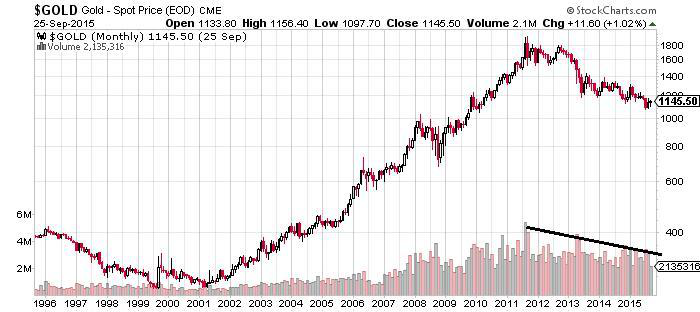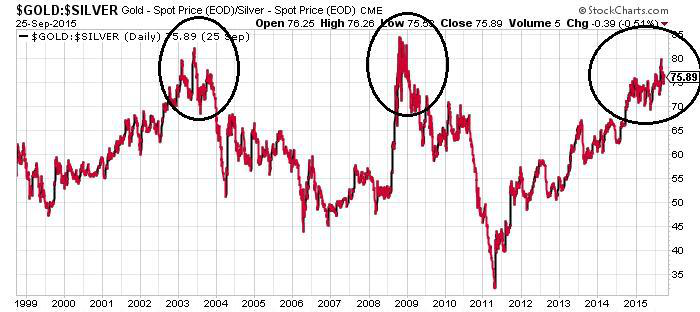Depressed Gold Prices Present Excellent Opportunity
Hope springs eternal for gold bulls. And 2016 might be the year. Currently trading near $1,125 per share, gold prices have been bearish since hitting around $1,900 an ounce in August 2011. That’s a decline of roughly 40%.
In 2015, gold prices are down 5.0% year-to-date. While there are still three months left in the year, there aren’t many people calling for a rebound in gold prices. This downward spiral has many precious metal investors worried about the gold price forecast. There are a lot of questions about where gold prices will go in 2016.
If you’re a gold bull and believe in buying undervalued investments with great upside, then you shouldn’t be too concerned. The yellow metal is shaping up to reward investors in 2016. Yes, 2015, and the few years before that, have been a little unnerving for gold investors, but the gold price outlook for 2016 and 2017 is very robust.
What Wall Street Thinks Gold Will Do in 2016
Don’t listen to the noise on Wall Street. It’s very misleading.
The mainstream media rarely falls on the side of precious metals like gold and silver. Why? Precious metals prices run in the opposite direction of the stock market. And being bullish on gold means being bearish on stocks. And there’s not a lot of commission hungry economists who want to espouse that.
Case in point, not too long ago, Citigroup Inc. (NYSE:C) lowered its outlook for gold prices. For 2016, the big bank believes gold prices will end the year at $1,050. This is down from a previous gold price forecast of $1,195. (Source: Reuters, July 31, 2015.)
Other big investment houses are singing the same tune. Some have even gone so far as to call gold a “pet rock.” Just sitting there…doing nothing. (Source: wsj.com, July 17, 2015.)
Gold Supply and Demand Out of Synch; Solid Move Ahead in 2016
Wall Street may have tarnished on gold but that’s not what the fundamentals and technical factors are saying about the future of gold prices. In fact, gold is setting up for a solid move to the upside in 2016.
Economics 101, supply and demand will justify the price of anything. Yup. Even for gold. When there’s a similar or higher demand and the supply is running low, you can expect higher prices.
As it stand in September 2015, we see demand rising and the supply side getting crushed. Even conservative central banks continue to pour into gold.
The second quarter of 2015 marked the 18th consecutive quarter where central banks were net buyers of gold bullion. Over that period of time, central banks purchased 137.4 tonnes of the yellow metal. This is 15% more than the five-year average of their demand. In the first quarter alone central banks purchased 123.6 tonnes of gold. (Source: World Gold Council, last accessed September 28, 2015.)
Sponsored Advertising Content: You’ll Never Guess Which BIG American Bank is Going Bankrupt NEXT?
If you take a closer look at central banks that already have significant holdings of gold….things become a little bit more interesting. They’re simply not selling. Take the Central Bank Gold Agreement for example. It’s an arrangement between the European Central Bank (ECB) and 20 other European central banks on how much gold they can sell in any given year. It’s a good idea when you consider these banks control about one fifth of all of the gold that has ever been mined.
Together, these European central banks have agreed that they will sell a maximum of about 400 tonnes of their gold reserves in any given year. In the last year, they have only sold 3.3 tonnes of gold bullion. Between 2013 and 2014, they only sold 6.8 tonnes, and just 5.1 tonnes a year before. (Source: World Gold Council, last accessed September 28, 2015.)
Remember, they have a self-imposed 400 tonne ceiling of gold bullion they can sell annually. Since 2009, these banks have only sold 210 tonnes. This is well below their quota.
Central banks that buy gold and refuse to sell says something important. For years, central banks shied away from holding a lot of gold. But, for some reason, their opinions have shifted. In fact, central banks remain net buyers of gold. And demand is expected to increase significantly in 2016, especially from small and emerging economies. They don’t have enough gold and they want more. No matter what the price.
Consumer Demand for Gold Remains Robust
Central banks are not the only ones stockpiling gold. There has been a massive surge in demand for gold from consumers as well. Back in 2013, we were told that consumer demand would vanish on low prices.
For instance, gold demand in India remains strong. In August 2015, the last month for which we have data, $4.95 billion worth of gold was imported into the country. During the same period last year, just $2.06 billion worth of gold was imported into India. This represents a year-over-year increase of 140%. Don’t be surprised if demand for gold in India continues to surge at a similar pace in 2016. (Source: India’s Ministry of Commerce & Industry, last accessed September 28, 2015.)
Then there’s China. In the second quarter of 2015 alone China consumed 216.5 tonnes of gold. This is significant. Especially when you consider these two countries account for more than half of global consumer demand for gold. Demand for gold from these two countries could soar in 2016 on the heels of stock market volatility and global growth concerns.
Sales figures at mints around the world are strong as well.
Year-to-date, the U.S. Mint has sold 658,000 ounces of gold bullion in American Eagle coins. If this pace continues, in 2015, the U.S. Mint could sell the highest amount of gold since 2011 – the year gold hit an all-time high of $1,900 an ounce. (Source:U.S. Mint, last accessed September 28, 2015.)
Other mints like the U.K’s Royal Mint, Australia’s Perth Mint, and the Canadian Mint have all reported that their demand is running high.
Will Gold Shortage Remain in 2016?
It’s important to keep in mind that there are really two prices when it comes to gold. These are futures prices and physical metal prices. Future prices are what you typically read about in the newspaper or hear about on the news. The “physical” price is what you pay when you purchase gold bullion. This prices comes at a premium.
We have been talking to some gold bullion dealers of late and it sounds like there is a shortage of gold bullion on the market. The premiums to purchase gold are shooting through the roof, reaching levels not seen since the financial crisis. On top of that, there are actually delays in deliveries.
This points to a massive shortage. With an influx of supply, you would expect to see lower premiums at the very least. This begs the question: If demand remains the same wouldn’t the shortage in the gold market just get worse in 2016?
This is Why Gold Prices Could Soar in 2016
Gold isn’t valued like stocks or bonds. Bullions does not pay dividends or interest. It’s typically valued on a supply and demand basis, the money supply, monetary policies, and geopolitical uncertainty.
We have already discussed what’s happening on the supply and demand side of gold. There are a number of other factors though that suggest gold is severely undervalued as well.
For example, if you look at the U.S Monetary Base, which is essentially all of the currency in circulation and deposits held by the Federal Reserve.
In 2008, the money circulation in the U.S. was around $830 billion. As you can see in the chart above, this figure currently stands at around $4.0 trillion. That’s a 380% increase in just a matter of a few years.
Unfortunately, the supply of fiat money around the world is facing a similar fate. Countries are printing money with reckless abandon. Throw a dart at a map and chances are good you’ll hit a country that is involved in printing money and its money supply has soared over the last few years.
Global uncertainty abounds. There could be a lot more of it in 2016. This would be welcome news for gold bulls in 2016.
Speaking of uncertainty, there are many questioning the long-term, sustainable strength of the global economy. Here in the U.S., some think U.S. economic growth of two percent is pretty solid, but if you look at the global economy, there are some issues that could undermine our economic growth. The fact of the matter is, a global recession is starting to look like a very plausible scenario. And weak economic growth from Chinese could set the dominos in action in 2016.
Organizations like the International Monetary Fund (IMF) have been pessimistic about the global economy. In 2016, it expects the global economy to advance 3.8%. This estimate is a little too ambitious. (Source: IMF.org, April, 2016.)
For starters, the ever optimistic IMF has a long history of revising its guidance lower. Second, who knows what’s going to happen politically and economically in 2016? There doesn’t seem to be any reason for us to think the economy is going to magically turn around and tensions in the Middle East and Europe are going to vanish. It would not be a big surprise to see the IMF lower its 2016 projections significantly lower.
There’s another development that could cause major inflows into the gold market; the Federal Reserve’s generous monetary policy.
The Federal Reserve, believing the U.S. economy to be strong enough, is expected to hike interest rates in early 2016 for the first time in nearly a decade. The majority of members on the Federal Open Market Committee (FOMC) believe that the federal funds rate will be 0.875% or higher by 2016 from the current 0.25%. That may not sound like much, but it’s a 250% increase from the current level. (Source: Federal Reserve, September 17, 2015.)
Keep in mind that the Federal Reserve’s easy monetary policies and artificially low interest rates, have been the fuel behind the current bull market. Even though the increase in rates isn’t significant, it will spook a lot of investors—especially in the bonds markets that have become overcrowded over last several years. If bonds and the stock markets face scrutiny, don’t be surprised to see more investments flocking toward gold in 2016.
Technical Analyses Points to Gold Prices Soaring in 2016
Fundamentals support a strong outlook for gold prices in 2016. But so too do technical. When it comes to gold, we are paying closer attention to the long-term trend and are not really paying attention to the short-term noise.
Chart courtesy of stockcharts.com
As you can see in the above chart, gold has been trending higher since 2002. Yes, gold absolutely hit a rough patch over the last few years, but if you look at the bigger picture, it doesn’t really amount to much.
To put it into perspective, since 2002, gold prices have advanced 300%. In the same period, key stock indices like the Dow Jones Industrial Average are up just 60%. Gold is outperforming stocks about five times.
Notice the black line at the bottom of the chart? That’s tracking volume. It’s interesting to note that volume is decreasing. What this really says is that there haven’t been as many sellers as there are buyers.
There’s also a key ratio that suggests gold prices are ready to make a serious move to the upside; the gold-to-silver ratio. This ratio shows how many ounces of silver it takes to purchase one ounce of gold bullion.
At times, the gold-to-silver ratio has been very accurate in predicting where gold prices are heading. For example, take a look at the chart below and look at the areas circled in red.
Chart courtesy of www.stockchart.com
The gold-to-silver ratio currently stands around 75. The last two times the ratio hit this level, a few months later we saw gold prices surge higher. This happened in 2008 and early 2003.
Gold Price Forecast for 2016
Gold is insurance for chaos. And there has certainly been a lot of that. Yet gold prices have not really been climbing as one might expect. So what does that say about gold being a safe haven investment?
There is one thing you can’t account for; investor sentiment and irrationality.
Investor sentiment is important. Right now, investors are sold on the idea that we will soon experience deflation and higher interest rates – neither of which are good for gold. This short-sighted perspective ignores the fundamentals and, as a result, investors are selling gold in a panic.
At Profit Confidential, we are paying attention to the basics, and the fundamentals and technicals are painting a strong picture for gold in 2016. With all of the developments in the markets, we would not be surprised to not just see gold advance in 2016, for the first time since 2013, but to make a serious move to the upside. One that could catch Wall Street entirely off guard.
As a result, we see gold as an excellent opportunity in 2016. We would not be surprised to see gold challenge 2013 highs next year and continue that trend in 2017 and beyond.
Best Gold Investments for 2016
If gold prices perform as expected in 2016, we believe mining companies will be the best way for investors to profit. Why? They provide leverage returns to gold prices. That said, not all gold mining companies are created equal.
Investors need to consider three factors when assessing a gold mining company:
- The quality of the assets – Look for gold mining companies with high or improving gold grades. That means it has strong and or growing reserves of gold.
- Location of assets – Make sure the company has gold mining assets in a country that is politically stable and business and mining-friendly. If not, investors could be in for a surprise, like the government seizing the property.
- Production costs – Keep an eye on All-in Sustaining Costs (AISC), this tells you how much it costs to produce an ounce of gold or silver. Look for gold mining companies with AISCs that are low and or improving. When production costs are low and managed closely, profit margins can be massive. Which should be reflected in the stock price.
Right now, there are a number of excellent low cost gold mining stocks out there (penny stocks, small-cap, mid-cap, and large-cap) with revenue generating mines, a strong cash position, increasing production levels, and decreasing costs. They could provide massive returns for investors in 2016.









